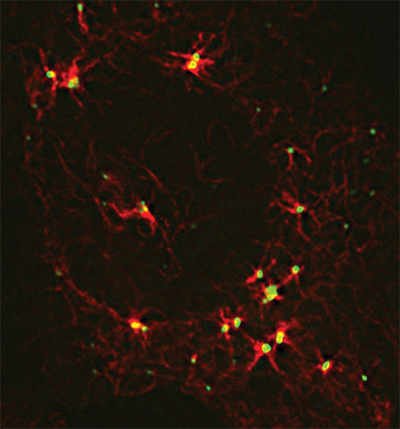JBC: A shadowy organizational hub in cells
On a cellular level, we are all hanging on by delicate threads. All cells are crisscrossed by a network of strands called microtubules, which act as railroad tracks that move cargo around the cell, as winch cables that separate chromosomes during cell division and as scaffolding components that give a cell its shape.
Because of its essential role in the cell cycle, microtubule assembly is the target of essential anti-cancer chemotherapies (paclitaxel, for example), which stop out-of-control cell division by destabilizing microtubules. Now, researchers have shed light on the role that a large, enigmatic protein plays in assembling microtubules, paving the way for better treatments. The results of the research were published in the Journal of Biological Chemistry.
 A large protein coordinates cellular components required for microtubule assembly.Courtesy of James Goldenring, Vanderbilt University
A large protein coordinates cellular components required for microtubule assembly.Courtesy of James Goldenring, Vanderbilt University
In 1999, James Goldenring’s research team at Vanderbilt University showed that protein kinase A-anchoring protein 350, or AKAP350, is a component of the centrosome, a center of microtubule organization in human cells. The team later showed that microtubules did not form efficiently without AKAP350. But the way in which AKAP350 regulated microtubule formation was difficult to understand, largely because of the technical challenges posed by AKAP350’s heft.
“Since this protein is so huge, it’s very difficult to study it,” said Elena Kolobova, the research scientist in Goldenring’s laboratory who led the new study. “A few years ago, we finally came to develop synthetic constructs of (AKAP350), which allowed us to go to the next level of evaluation and function.”
Using a combination of detailed biochemical analyses and super-resolution microscopy, the team finally was able to gain some understanding of the complex roles that AKAP350 plays in regulating microtubules in cells. AKAP350 formed a physical bridge spanning components of the centrosome. And AKAP350 appeared to recruit multiple proteins involved in building microtubules, coordinating their function in one spot.
“I like to call this thing Deep Space Nine. Everybody comes to hang out at AKAP350,” Goldenring said. “I think we’ve only scratched the surface of the structural organization that this protein is probably providing.”
Mutations in AKAP350 have been associated with cardiac arrhythmias, so it will be of interest to see whether the protein’s role in microtubule assembly contributes to proper heart function as well.
“I think (AKAP350) is a fundamental regulator of cell function,” Goldenring said. “So we need to know a lot more about this protein before we can even begin looking at what it might mean for disease.”
Enjoy reading ASBMB Today?
Become a member to receive the print edition four times a year and the digital edition monthly.
Learn moreGet the latest from ASBMB Today
Enter your email address, and we’ll send you a weekly email with recent articles, interviews and more.
Latest in Science
Science highlights or most popular articles

The science of staying strong
Muscles power every movement, but they also tell the story of aging itself. Scientists are uncovering how strength fades, why some species resist it and what lifestyle and molecular clues could help preserve muscle health for life.

Bacteriophage protein could make queso fresco safer
Researchers characterized the structure and function of PlyP100, a bacteriophage protein that shows promise as a food-safe antimicrobial for preventing Listeria monocytogenes growth in fresh cheeses.

Building the blueprint to block HIV
Wesley Sundquist will present his work on the HIV capsid and revolutionary drug, Lenacapavir, at the ASBMB Annual Meeting, March 7–10, in Maryland.

Gut microbes hijack cancer pathway in high-fat diets
Researchers at the Feinstein Institutes for Medical Research found that a high-fat diet increases ammonia-producing bacteria in the gut microbiome of mice, which in turn disrupts TGF-β signaling and promotes colorectal cancer.

Mapping fentanyl’s cellular footprint
Using a new imaging method, researchers at State University of New York at Buffalo traced fentanyl’s effects inside brain immune cells, revealing how the drug alters lipid droplets, pointing to new paths for addiction diagnostics.

Designing life’s building blocks with AI
Tanja Kortemme, a professor at the University of California, San Francisco, will discuss her research using computational biology to engineer proteins at the 2026 ASBMB Annual Meeting.

.jpg?lang=en-US&width=300&height=300&ext=.jpg)